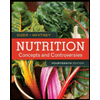
MICRO. FUND. CONNECT CODE W/VIRTUAL LAB
3rd Edition
ISBN: 9781266313806
Author: Cowan
Publisher: INTER MCG
expand_more
expand_more
format_list_bulleted
Question
Chapter 22.4, Problem 7AYP
Summary Introduction
To outline:
The three phases of wastewater treatment.
Concept introduction:
The wastewater treatment processes are mainly divided into three stages: the primary phase, a secondary phase, and a tertiary phase. The wastewater is treated to ensure the safe drinking of water and to eliminate the harmful pathogens. The sewage that is piped to wastewater treatment is subjected to physical, biological, and sometimes chemical processes.
Expert Solution & Answer
Want to see the full answer?
Check out a sample textbook solution
Students have asked these similar questions
Which evidence-based stress management techniques are most effective in reducing chronic stress and supporting college students’ academic success?
students in a science class investiged the conditions under which corn seeds would germinate most successfully. BAsed on the results which of these factors appears most important for successful corn seed germination.
I want to write the given physician orders in the kardex form
Chapter 22 Solutions
MICRO. FUND. CONNECT CODE W/VIRTUAL LAB
Ch. 22.1 - Draw your own representation or logo depicting how...Ch. 22.2 - Provide a definition for zoonosis.Ch. 22.2 - Discuss the effects of deforestation and...Ch. 22.3 - Differentiate between coliforms and E. coli.Ch. 22.3 - Prob. 5AYPCh. 22.3 - Prob. 1MMCh. 22.3 - Q. What further precautions can vulnerable people...Ch. 22.4 - Define biological oxygen demand.Ch. 22.4 - Prob. 7AYPCh. 22.4 - Prob. 8AYP
Ch. 22 - Prob. 1QCh. 22 - In Malaysia, a form of malaria that was previously...Ch. 22 - Prob. 3QCh. 22 - Prob. 4QCh. 22 - Why do you think microbes are so adept at breaking...Ch. 22 - Prob. 6QCh. 22 - Contaminated water has a. lower biological oxygen...Ch. 22 - Why do microbes exist that are capable of cleaning...Ch. 22 - Prob. 9QCh. 22 - Prob. 10QCh. 22 - Prob. 11QCh. 22 - With what you have learned about increasingly...Ch. 22 - Prob. 13QCh. 22 - Explain how a warming climate is likely to impact...Ch. 22 - Conduct research to find out where the...Ch. 22 - Prob. 16QCh. 22 - Prob. 17QCh. 22 - Zika virus infection in adults may be asymptomatic...Ch. 22 - Prob. 19QCh. 22 - Prob. 20QCh. 22 - Prob. 21QCh. 22 - Prob. 1VC
Knowledge Booster
Learn more about
Need a deep-dive on the concept behind this application? Look no further. Learn more about this topic, biology and related others by exploring similar questions and additional content below.Similar questions
- Amino Acid Coclow TABle 3' Gly Phe Leu (G) (F) (L) 3- Val (V) Arg (R) Ser (S) Ala (A) Lys (K) CAG G Glu Asp (E) (D) Ser (S) CCCAGUCAGUCAGUCAG 0204 C U A G C Asn (N) G 4 A AGU C GU (5) AC C UGA A G5 C CUGACUGACUGACUGAC Thr (T) Met (M) lle £€ (1) U 4 G Tyr Σε (Y) U Cys (C) C A G Trp (W) 3' U C A Leu בוט His Pro (P) ££ (H) Gin (Q) Arg 흐름 (R) (L) Start Stop 8. Transcription and Translation Practice: (Video 10-1 and 10-2) A. Below is the sense strand of a DNA gene. Using the sense strand, create the antisense DNA strand and label the 5' and 3' ends. B. Use the antisense strand that you create in part A as a template to create the mRNA transcript of the gene and label the 5' and 3' ends. C. Translate the mRNA you produced in part B into the polypeptide sequence making sure to follow all the rules of translation. 5'-AGCATGACTAATAGTTGTTGAGCTGTC-3' (sense strand) 4arrow_forwardWhat is the structure and function of Eukaryotic cells, including their organelles? How are Eukaryotic cells different than Prokaryotic cells, in terms of evolution which form of the cell might have came first? How do Eukaryotic cells become malignant (cancerous)?arrow_forwardWhat are the roles of DNA and proteins inside of the cell? What are the building blocks or molecular components of the DNA and proteins? How are proteins produced within the cell? What connection is there between DNA, proteins, and the cell cycle? What is the relationship between DNA, proteins, and Cancer?arrow_forward
- please fill in the empty sports, thank you!arrow_forwardIn one paragraph show how atoms and they're structure are related to the structure of dna and proteins. Talk about what atoms are. what they're made of, why chemical bonding is important to DNA?arrow_forwardWhat are the structure and properties of atoms and chemical bonds (especially how they relate to DNA and proteins).arrow_forward
- The Sentinel Cell: Nature’s Answer to Cancer?arrow_forwardMolecular Biology Question You are working to characterize a novel protein in mice. Analysis shows that high levels of the primary transcript that codes for this protein are found in tissue from the brain, muscle, liver, and pancreas. However, an antibody that recognizes the C-terminal portion of the protein indicates that the protein is present in brain, muscle, and liver, but not in the pancreas. What is the most likely explanation for this result?arrow_forwardMolecular Biology Explain/discuss how “slow stop” and “quick/fast stop” mutants wereused to identify different protein involved in DNA replication in E. coli.arrow_forward
arrow_back_ios
SEE MORE QUESTIONS
arrow_forward_ios
Recommended textbooks for you
- Basic Clinical Lab Competencies for Respiratory C...NursingISBN:9781285244662Author:WhitePublisher:Cengage
 Nutrition: Concepts and Controversies - Standalo...Health & NutritionISBN:9781305627994Author:Frances Sizer, Ellie WhitneyPublisher:Brooks Cole
Nutrition: Concepts and Controversies - Standalo...Health & NutritionISBN:9781305627994Author:Frances Sizer, Ellie WhitneyPublisher:Brooks Cole Concepts of BiologyBiologyISBN:9781938168116Author:Samantha Fowler, Rebecca Roush, James WisePublisher:OpenStax College
Concepts of BiologyBiologyISBN:9781938168116Author:Samantha Fowler, Rebecca Roush, James WisePublisher:OpenStax College


Basic Clinical Lab Competencies for Respiratory C...
Nursing
ISBN:9781285244662
Author:White
Publisher:Cengage



Nutrition: Concepts and Controversies - Standalo...
Health & Nutrition
ISBN:9781305627994
Author:Frances Sizer, Ellie Whitney
Publisher:Brooks Cole

Concepts of Biology
Biology
ISBN:9781938168116
Author:Samantha Fowler, Rebecca Roush, James Wise
Publisher:OpenStax College
Photosynthesis & Respiration | Reactions | Chemistry | FuseSchool; Author: FuseSchool - Global Education;https://www.youtube.com/watch?v=3XIyweZg6Sw;License: Standard YouTube License, CC-BY